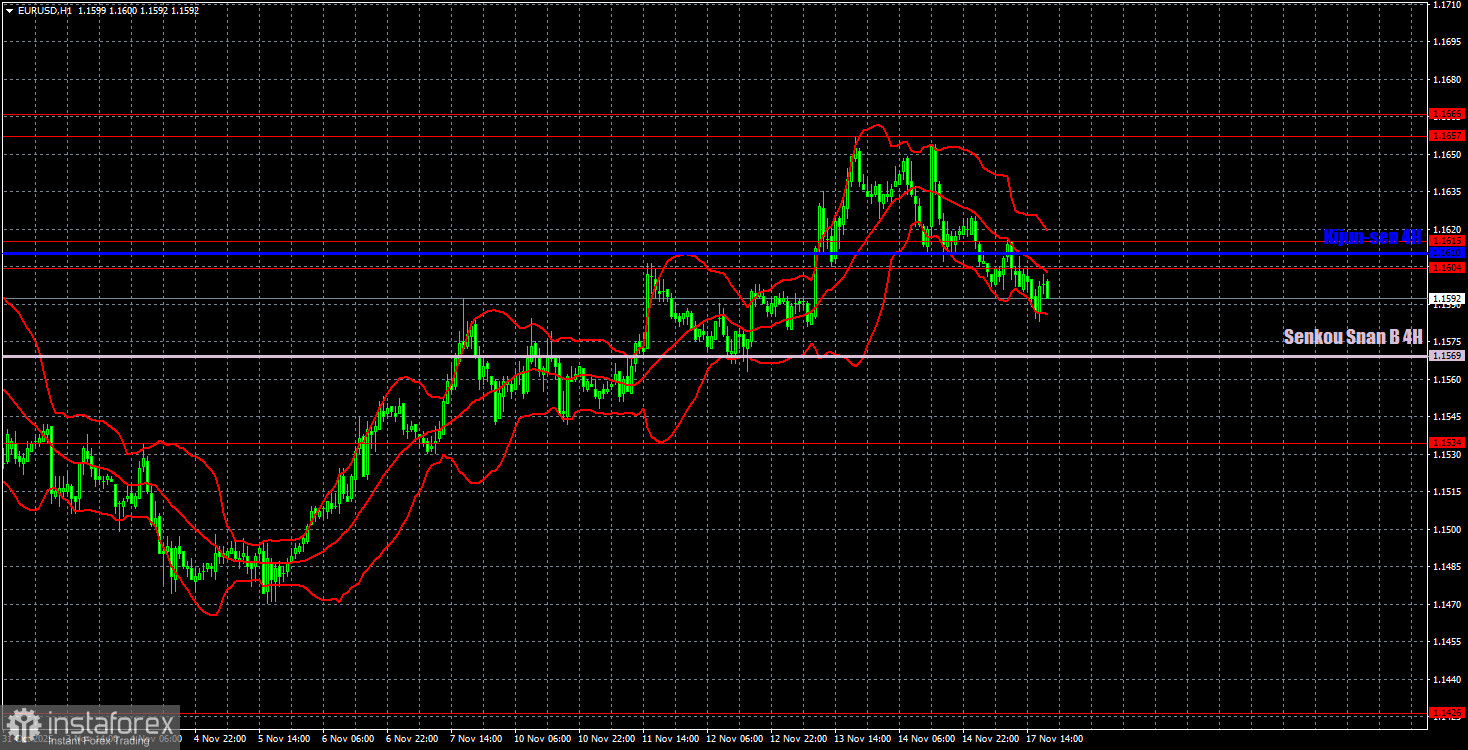Forex Analysis & Reviews: Trading Recommendations and Analysis for EUR/USD on November 17: EU Economy Lacks Attention
Analysis of EUR/USD 5M
The EUR/USD currency pair maintained its upward momentum from the last two weeks on Friday but failed to extend gains. Throughout the day, volatility was relatively low, yet prices still fluctuated in various directions. Overall, the macroeconomic backdrop on that day was highlighted by just one report: the Eurozone GDP for the third quarter. The EU economy grew by 0.2% quarter-on-quarter and by 1.4% year-on-year. However, the report was released as a second estimate, which is the least significant and least interesting to traders. As a result, there was no reaction to this report, and during the European trading session, the euro weakened. During the American trading session, it was announced that the government shutdown had officially ended, though it could resume in February of next year. The U.S. dollar initially fell by 40 pips, then rose by 40 pips, marking the end of the day's movements on the last trading day of the week. The hourly timeframe continues to show an upward trend, but there is no clear trend line due to the absence of a second distinct extreme. On the 5-minute timeframe, two trading signals were formed on Friday. First, the price bounced off the area of 1.1604–1.1615, and about an hour later, it worked within three pips of the area of 1.1657–1.1666 before bouncing off it. Thus, the first trading signal could be executed without doubt, while the second could not incur any losses.
COT Report
The latest COT report is dated September 23. Since then, no further COT reports have been published due to the U.S. "shutdown." In the illustration above, it is clear that the net position of non-commercial traders has long been "bullish," with bears struggling to gain the upper hand at the end of 2024 but quickly losing it. Since Trump took office for a second term as President of the U.S., the dollar has been falling. We cannot assert that the decline of the American currency will continue with 100% probability, but current world events suggest that this may be the case. We still do not see any fundamental factors that would strengthen the euro, while there remain sufficient factors that would weaken the dollar. The global downtrend is still ongoing, but what difference does it make where the price moved in the last 17 years? Once Trump concludes his trade wars, the dollar may start to rise, but recent events indicate that the war will continue in one form or another for a long time yet. The position of the red and blue lines of the indicator continues to indicate the preservation of a "bullish" trend. During the last reporting week, the number of long positions in the "Non-commercial" group decreased by 800, while the number of shorts increased by 2,600. Consequently, the net position decreased by 3,400 contracts over the week. However, this data is already outdated and holds no significance.
Analysis of EUR/USD 1H
On the hourly timeframe, the EUR/USD pair continues to form a new upward trend. The current rise in the euro does not align with the local macroeconomic backdrop and fundamentals, but it does align with the global picture. The price remains within the daily range of 1.1400–1.1830, so a rise to the 1.1800 level can be anticipated even in the context of a local trend. For November 17, we highlight the following levels for trading: 1.1234, 1.1274, 1.1362, 1.1426, 1.1534, 1.1604–1.1615, 1.1657–1.1666, 1.1750–1.1760, 1.1846–1.1857, 1.1922, 1.1971–1.1988, as well as the Senkou Span B line (1.1569) and Kijun-sen (1.1599). The Ichimoku indicator lines may shift during the day, which should be considered when determining trading signals. Don't forget to set stop-loss orders to break even once the price moves in the desired direction by 15 pips. This will protect against potential losses in the event of a false signal. On Monday, no important or even interesting events/reports are scheduled in the Eurozone or the U.S. Thus, volatility is unlikely to rise significantly beyond the average of about 50 pips. Throughout the day, the pair is expected to trade mostly sideways. Trading Recommendations: On Monday, traders may open long positions if there is another bounce from the 1.1604–1.1615 area, targeting 1.1657–1.1666. Short positions will become relevant upon a bounce from the area of 1.1657–1.1666, targeting 1.1604–1.1615.
Analysis are provided by InstaForex.
Read more: https://ifxpr.com/3LJOwBl


 3Likes
3Likes LinkBack URL
LinkBack URL About LinkBacks
About LinkBacks









 Reply With Quote
Reply With Quote



Bookmarks